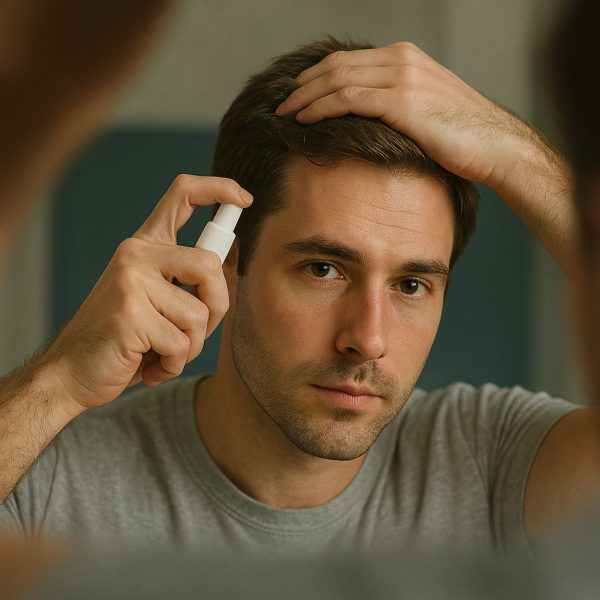
Finasteride and Minoxidil have been in competition since Finasteride came onto the market in 1997, but which product will give the best result?
- Finasteride – the active ingredient in Propecia.
- Minoxidil – the active ingedient in Rogaine.
Finasteride: Explained
Taking a single pill to reverse male pattern baldness sounds like a dream come true for those who find themselves thinning on top.
In pill form and FDA-approved, Finasteride only needs to be taken once a day and has been reported to grow hair in around 66% of individuals after 2 years of treatment.
How Finasteride works
Male pattern baldness (androgenetic alopecia) is the result of the hormone DHT (Dihydrotestosterone) latching on to genetically susceptible hair follicles – at the front and top of the scalp; and on the crown.
DHT causes these follicles to shrink in diameter and length, resulting in what’s known as miniaturised follicles. They produce small, unpigmented, barely noticeable hairs where there used to be normal strands, leaving the tell-tale M-shaped receding hairline.
Finasteride – also known as Propecia – works by blocking the enzyme (5-alpha reducatase) that causes the conversion of testosterone to DHT.
How effective is Finasteride?
Finasteride causes a significant drop in both scalp and blood levels of DHT – around 70% in the case of serum DHT levels.
According to studies, beyond the initial two years of treatment, approximately 83% of Finasteride users have maintained their hair. After five years of treatment, 90% of Finasteride users experienced either new hair regrowth or their hair loss stopped. Looking more closely, 48% of users experienced increased hair growth, 42% reported having no hew hair loss and the remaining 10% were rated as having lost hair.
Two specific studies provided the following data:
- Hair Count Clinical Study – Hair counts showed an average increase of 277 hairs per one-inch circle after five years and those hairs were significantly larger than the fine, miniaturised hairs that are typical of balding.
- Hair Weight Clinical Study – At 96 weeks, an increase of 34% in hair weight was observed between Finasteride and placebo users.
Finasteride dosage
The recommended dosage of Finasteride is 1mg per day.
You can purchase generic brand Proscar very cheaply in 5mg doses and cut the tablets into fifths. It’s not necessary to be precise; generally, one fifth of the tablet per day is fine. Otherwise, go for the 1mg branded Propecia tablets. It can be taken with or without meals.
TOP TIP
If you decide on using Proscar, be sure to purchase it from a reliable, legitimate source. Be vigilant when purchasing from online retailers. See your GP who can prescribe it to you, or their are private GP services who can provide a private prescription to your door; normally at a very affordable cost (c. less £200 for a 14 month supply).
Side effects of Finasteride
Finasteride can, however, have side effects:
- A full head of hair could come at the risk of gaining breasts where your pecs should be.
- You could also stop balding but you may also have a decreased sex drive.
The side effects are not life-threatening, but as with all drugs, there is a trade-off. You may be relieved of one problem, but you may encounter another.
Side effects of Finasteride don’t appear to be massively common. In the same study, patients reported 1.5% greater side effects in the control group than in the placebo group after one year. 3.8% of men on 1mg of Finasteride reported some sexual dysfunction, compared with 2.1% on the placebo.
After five years of those taking the drug, 0.3% reported decreased sex drive, 0.3% reported erectile dysfunction and 0.0% (none) reported decreased volume of ejaculate. And yes, there have been patients who have reported gynecomastia, or male breast tissue growth.
It’s important to note that most reported cases of sexual dysfunction occurred soon after commencing Finasteride.
The good news is that sexual side effects were reversed once therapy was discontinued and in 58% of patients who continued to take the drug. Those who stopped taking it noted that the side effects disappeared within a few weeks. Anecdotally, some patients have reported side effects persisting after they have stopped taking the drug.
Meanwhile, in those who stopped taking Finasteride, their hair loss didn’t worsen as such but they only lost a volume of hair that was equivalent to that which had been gained or preserved whilst on the drug.
If you decide to take Finasteride, the benefits – along with any side effects – will cease when you stop taking it but you won’t necessarily be any worse off in terms of your hair.
Drug interactions with Finasteride
No drug interactions of clinical importance have yet been identified.
Finasteride: Pros
- Highly effective in the vast majority of users.
- Halts hair loss and can even generate new growth.
- Available without prescription (recommend discussing with your doctor or hair loss specialist).
- A quick, easy and convenient daily oral dose.
- Pain-free hair loss therapy that requires no down-time.
- You can stop taking it without any problems. If you’ve experienced any side effects, they should disappear.
- FDA-approved as safe.
Finasteride: Cons
- Propecia (branded Finasteride) can be expensive at around £45-55 per month ($65 USD).
- Side effects can include decreased libido, lower semen production, softer erections and gynecomastia.
- Shedding is experienced by a small number of men in the first 3-6 months of treatment.
- It can take up to a full year to see the effects of Finasteride.
- Need to commence Finasteride therapy as early as possible.
Give it time to work
You’ll need to give Finasteride a year or longer before you can accurately assess its effects on preventing hair loss and re-growing hair.
Within the first six months, you may even notice some thinning of your existing hair. This can be due to either progression of your hair loss before the drug has started to work, or some shedding of the miniaturised hairs to make way for new, healthy hair to grow.
What happens if you stop taking Finasteride?
Any benefits you experience from taking Finasteride will cease if you discontinue it. In the ensuing 2-6 months, your hair loss pattern will likely return to the state it would have been if you hadn’t taken the drug. Speak to a professional before taking Finasteride, either your GP or a hair loss specialist.
Combining Finasteride with hair transplantation
Finasteride has been proven to complement hair transplants. As it is less effective in the front of the scalp, surgical hair restoration offers the greatest cosmetic improvement.
Finasteride can also regrow hair and/or stabilise hair loss in the rear of the scalp where hair transplantation may not be feasible. The drug can also be an early solution for younger men who may not yet be a candidate for hair transplantation surgery.
Remember that surgery cannot regrow hair. Complementing the surgical option with Finasteride is a far more holistic approach.
“I can tell you that I have experienced great results with Finasteride since starting to take it 16 years ago. It immediately halted any further progression of hair loss for me and I noticed that it thickened up my hair volume along the entire mid/crown section. I consider Finasteride to be my ultimate weapon in the war against hair loss. Even having had a hair transplant, I continue taking the drug to prevent any additional hair casualties.
Your own experience may be different to mine but, armed with what you now know, you will at least understand what you may expect to occur for you.”
– Spex (this article’s author) has used Finasteride.
Minoxidil: how it works
The truth is that nobody really understands yet why Minoxidil can stimulate hair re-growth. It is also important to mention that Minoxidil does not work for every case of male-pattern baldness. Some research suggests that Minoxidil is more effective when treating earlier cases of alopecia and less effective when the hair loss is already more extensive.
For around half of the men who try Minoxidil, male pattern baldness slows down noticeably. About fifteen percent of individuals will see their hair strengthening and thickening. Around 33%, unfortunately, see no change at all to their male-pattern baldness. Minoxidil also tends to work better in younger men.
Finasteride vs. Minoxidil
Finasteride was – like Minoxidil – originally designed to treat another problem; in this case benign prostatic hyperplasia (an enlarged prostate).
It was deemed safe for use in 1992 and was developed into a hair loss cure in 1997 – being used in either liquid or foam form, and applied twice a day
So, what should you be using?
The American Hair Loss Association, an organisation dedicated to improving the lives of all those affected by hair loss, confidently proclaims Finasteride — the active ingredient in Propecia — the first line of attack for all men interested in treating their male pattern baldness.
The AHLA does, however, believe that minoxidil (Rogaine’s active ingredient) still has an important role to play, particularly for those who have not had satisfactory results from Propecia or would like to add another product to their treatment regimen.
Minoxidil – in laymen’s terms – works differently to Finasteride. It helps increase and keep the blood supply to the scalps network of capillaries and keeps the blood pumping to the needy follicles that are being attacked by DHT. Minoxidil essentially works by resuscitating those dying networks. Finasteride works its hardest at blocking the DHT that is attacking the follicle. Used together, they can have a synergetic effect.
There are two main differences between Minoxidil and Finasteride:
- Unlike Minoxidil, in the UK you will need a prescription before you can buy Finasteride;
- Finasteride is taken orally in pill form rather than as a solution or foam.
It is important that you remember that like Minoxidil, you should not handle a broken Finasteride pill if you are pregnant.
The side effects of Finasteride can also be more severe with more of them being linked to sexual problems such as erectile dysfunction, impotence, and testicular pain.
Finasteride worked in around 80% of cases, compared to Minoxidil working at around 52%. If taken alone, Finasteride is the better drug to take, though many people advocate using them both, dubbing them the ‘dynamic duo’.
Guest editorial by Spencer “Spex” Stevenson. For further insight into proven hair loss treatments visit Spex’s site at www.spexhair.com
























































